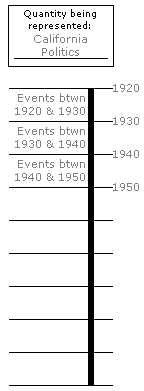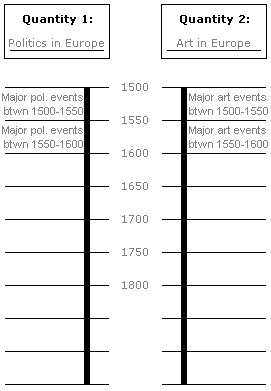Timelines and Parallel Timelines
Introduction and Best Uses
Timelines are used to depict information and/or events in chronological order, i.e., according to time (or other regular intervals).
Timelines or Interval Graphs

A timeline (also known as an interval graph) shows a vertical line with "tick marks" on it. These tick marks are meant to indicate time intervals. These could be intervals of one year, ten years, a whole century, or any other regular interval, depending on the purpose and scope of the timeline. For example, the intervals could be decades and the related information could be events that occurred during each decade in a particular country or region, in order to show a chronological sequence of events.
The timeline in Figure 1, given as an example, identifies the topic or "quantity being represented" as "California politics." The first few tick marks are labeled 1920, 1930, 1940, etc. The area between 1920 and 1930 is labeled "Events between 1920 and 1930" because that is where you would list the specific, important events in California politics that occurred between 1920 and 1930.
Parallel Timelines or Parallel Interval Graphs

A parallel timeline or parallel interval graph shows two timelines side by side. These timelines share the same values for their tick marks or time intervals, so that the two entities can be compared. For example, the intervals could be half a century (50 years), and you could compare developments in art with developments in politics.
The example parallel timeline shown in Figure 2 identifies "quantity 1" as "Politics in Europe" and "quantity 2" as "Art in Europe." The first few tick marks are labeled 1500, 1550, 1600, 1650, etc. The area between 1500 and 1550 for quantity 1 is labeled "Major political events between 1500 and 1550" because that is where you would list the specific, important events in European politics that occurred during the first half of the 16th century. The area between 1500 and 1550 for quantity 2 is labeled "Major art events between 1500 and 1550" because that is where you would list the specific, important events in European art that occurred during the same time period.